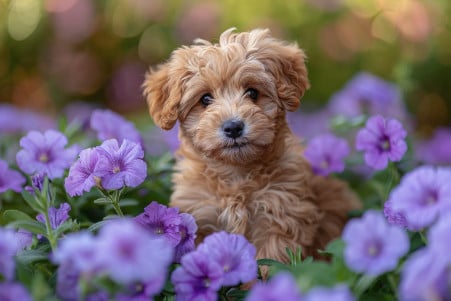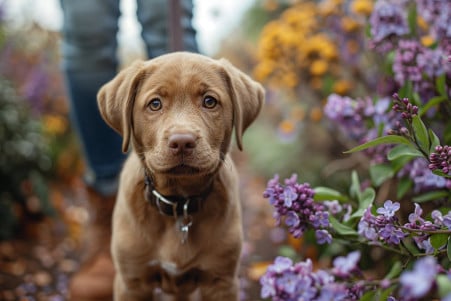Can Dogs Eat Tulips? What Pet Owners Should Know
23 April 2024 • Updated 23 April 2024

Tulips are a classic sign of spring and their bright blooms are a welcome addition to gardens and homes. If you’re a dog owner, however, you may be concerned about whether tulips are safe to have around your pet. After all, many common plants are toxic to dogs, and tulips are no exception. Tulips are toxic to dogs and contain allergens such as tulipalin A and tuliposides. If a dog eats any part of the tulip plant, they may experience vomiting, drooling, diarrhea, and lethargy, and in some cases, more severe symptoms like changes in heart rate and breathing.
To learn more about the dangers tulips pose to dogs and how to make sure your pet stays safe, we’ll cover veterinary case reports and toxicology studies. We’ll also get insights from professional horticulturists and pet professionals on how to recognize symptoms and the best ways to treat your dog if they eat a tulip. Armed with this information, you can make sure your dog stays safe while you enjoy these beautiful flowers.
Are tulips toxic to dogs?
Tulip Toxicity in Other Animals
Tulips are toxic to cats, and consumption can result in symptoms such as gastrointestinal upset (vomiting, diarrhea), lethargy, anorexia, drooling, abdominal pain, and in severe cases, cardiac arrhythmias, tremors, and seizures, according to The Spruce Pets. Horses are susceptible to the toxic principles in tulips, tulipalin A and B, and can experience gastrointestinal irritation, depression of the central nervous system, convulsions, and cardiac abnormalities if ingested, according to Penn State Extension.
Dogs and cats are more likely to consume tulips out of curiosity, but horses may accidentally eat them while grazing in areas where tulips are growing. In all cases, tulip bulbs are the most dangerous part of the plant because they contain the highest concentrations of toxic principles like tulipalin A and B, as well as calcium oxalate crystals, which can cause irritation in the mouth, stomach, and intestines, according to The Wildest. Veterinary care should be sought immediately if tulip poisoning is suspected in any animal, as this will offer the best chance of a positive outcome.
How to Tell If Your Dog Has Eaten Tulips
Signs of tulip poisoning in dogs can happen soon after the plant is eaten and can range in severity, says Tulip Poisoning in Dogs - Symptoms, Causes, Diagnosis, Treatment, Recovery, Management, Cost. Common symptoms include vomiting, diarrhea, drooling, weakness, and stomach upset.
In more serious cases, dogs can have changes in their heart rate, breathing issues, shaking, and even seizures, reports Are tulips poisonous to dogs? - Pure Pet Food. The severity of the symptoms can depend on how much of the plant was eaten and if the bulb or leaves and stems were consumed, explains Are Tulips Poisonous to Dogs? | TrustedHousesitters.com.
It’s important to recognize these signs so that you can get your pet to the vet as soon as possible, which can increase the likelihood of a full recovery. If you suspect that your dog has eaten tulips, call your vet right away.
First Aid and Veterinary Care
If a dog has eaten tulips, immediate veterinary treatment is necessary for the best chance of recovery, says Tulips & Hyacinths Are Toxic To Pets | Pet Poison Helpline®. This may include inducing vomiting or giving activated charcoal to help prevent the body from absorbing the toxins. In addition, supportive care, like IV fluids and observation, may be needed to help manage symptoms and prevent further issues, according to Tulip Toxicity in Dogs and Cats | FirstVet.
In more serious cases, treatment like medications to help with abnormal heart rhythms or breathing problems may be necessary, says Spring toxin 1: Tulips and hyacinths. There is no specific treatment for tulip poisoning, but with early treatment and the right care, a dog’s prognosis is good.
How to Avoid Tulip Toxicity in Dogs
The most effective way to prevent tulip poisoning in dogs is to avoid exposure to these plants entirely. While working in the garden, make sure dogs are kept away from areas where tulips are being planted or stored, and think about putting up a barrier around tulip beds, per Dogs Today Magazine. In the house, make sure tulips are kept out of reach and disposed of properly when they start to wilt.
You can also help prevent dogs from investigating or eating tulips by training them to respond to commands like 'leave it' or 'drop it,' says Rover.com. Or you could opt to plant dog-friendly flowers like roses, sunflowers, or snapdragons in your garden instead of tulips, according to Southern Living.
Safe Ways to Handle and Dispose of Tulips
To minimize the risk of exposure to tulips, it's important to wear gloves when handling the flowers to prevent skin irritation and to keep dogs from accidentally eating them, according to Greg.app. In addition, make sure to dispose of tulips as soon as they start to wilt and do so in a way that prevents dogs from getting to the plant material.
If you're planting tulip bulbs in the garden, it's important to supervise dogs when you do this and to clean up any bulbs that you drop or that are otherwise exposed since the bulbs have the highest concentration of toxins, says the ASPCA. You can also use pet-safe repellents or barriers to keep dogs away from tulip beds.
In addition, the ASPCA notes that it's important to make sure that family members and guests are aware of the dangers that tulips pose to pets and the need to handle and dispose of them carefully. With these measures in place, dog owners can enjoy tulips in their gardens and homes without worrying about their pets' safety.
Conclusion: How to Protect Dogs from Tulip Toxicity
According to the ASPCA, tulips are toxic to dogs, cats, and horses. The toxic principles in tulips, tulipalin A and B, can cause vomiting, depression, diarrhea, and excessive drooling in pets. The highest concentration of these toxic principles is found in the bulbs, which are therefore the most dangerous part of the plant.
While tulips are a popular spring flower, they can be dangerous to our furry friends. Pure Pet Food notes that many of the most popular flowering plants, including tulips and daffodils, are highly toxic to dogs. However, there are plenty of dog-friendly plants that can be safely planted in the garden, including roses, sunflowers, and fuchsias.
Pet parents should work to minimize the risk of tulip poisoning by keeping dogs away from areas where tulips are growing or being stored. It's also important to make sure that tulips are handled and disposed of properly to avoid accidental ingestion. With these precautions in place, dog owners can enjoy the beauty of tulips without worrying about their pets' safety.


